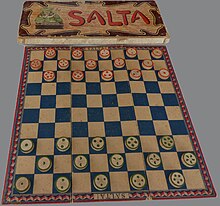Salta (game)

Salta (from Latin Springe! ) Is a board game similar to the checkers game or the Halma , which was invented in 1899 by Konrad Heinrich Büttgenbach (1870–1939), a musician from Düsseldorf. Salta enjoyed great popularity around 1900: the game received a gold medal at the World Exhibition in Paris , international tournaments were held in Monte Carlo , Kaiser Wilhelm II had a magnificent Salta game made with gem-set pieces, Sarah Bernhardt played against the inventor of Salta , and also world chess champion Emanuel Lasker , played with this game. Salta seemed to displace the checkers game, but interest soon disappeared again in the following years, so that Salta games are hardly to be found today.
The following description is based on Meyer's Konversationslexikon from 1908.
The rules
Salta is played by two people who alternate their moves on a chessboard of 100 fields with 15 pieces each (green symbols on white pieces and red symbols on black pieces; the players are called white and black , analogous to the chess game ). The position on the board is like in chess ; d. H. each player has a white space on their right. However, the designation of the fields is different: Since the game is only played on the black fields, only they are given a number, line by line from 11 to 15, 21 to 25, etc. up to the last line, which is numbered from 101 to 105.
The stones are all equal and move one step diagonally forwards or backwards. They are only referred to as star 1–5 (the row closest to the player), moon 1–5 (2nd row) and sun 1–5 (3rd row) because they have to be led into the opposing camp and finally to be set up there in the same order and numbering, so that the green suns strive for the fields of the red stars, the green moons the fields of the red moons, the green stars the fields of the red suns and vice versa; where the order 1-5 does not change, i.e. H. it remains in ascending order from left to right (from the perspective of the player).
Jump will only forward a hostile stone on an empty field, as with Dame, but the hostile stone according to the game destination stops a beating does not exist in Salta . It is not allowed to jump twice in one move. A jump possible for the player must be done, the failure to repudiate the opponent by shouting: "Salta!". A move or jump must always be kept open to the opponent.
White begins to move. The winner is whoever fulfills the purpose of the game first, and the number of moves that the other person would still have to make for the same purpose indicates how many points were won. According to the tournament rules , each game ends after 120 moves at the latest. If there are still no stones on their target field, they are moved there as if the opposing stones did not exist. A game is drawn if both players required the same number of moves.
marketing
Although Salta appeared at a time when there were neither demoscopes nor electronic media, it was cleverly marketed. Tournaments with substantial cash prizes ( around 20,000 Swiss francs in Monaco ) and reviews by chess grandmasters brought the game feature articles both in the gazebo and in the New York State newspaper . Meyer's Conversationslexikon devoted a whole page to the game, and several textbooks and its own German Salta newspaper were published . Cheap versions for 2.50 marks were available as well as luxury versions for over 400 marks.
Versions
For single players, the Solitaire variant Salta Solo appeared , for which there were brochures with easy and extremely difficult training units and tasks.
literature
- Baron von Alvensleben: How to play Salta: A thorough guide to learning this board game, along with the most common ways of fighting and some sample games . Ernst, Leipzig 1901, online at archive.org .
- RC Bell: Board and Table Games from Many Civilizations . Dover Publications, New York 1969, Vol. II.
- R. Gering: Salta: The Humanistic Game ( Memento of March 3, 2006 in the Internet Archive ), In: Abstract Games Magazine 2001; Issue 8: 12-13.
- CD Grupp: Tactical Games from Around the World: An introduction to the most exciting games without cards and dice . ASS Verlag, Leinfelden 1974.
- W. Shepherd: Our games . Verlag für die Frau, Leipzig 1971.
- RF Müller: Queen: Duel with flat stones . Econ, Düsseldorf 1988.
- R. Rühle: The forgotten bestseller: Salta . In: Die Pöppel-Revue , 1998, 21, pp. 42–43.
- RW Schmittberger: New Rules for Classic Games . John Wiley & Sons, New York 1992.
- Hermann Schubert : Salta, the new board game . Grethlein & Co., Leipzig 1899 (1st edition, online at archive.org ) / 1908 (2nd edition).
- Hermann Schubert: Salta and Salta-Solo (miniature library No. 382) . Verlag für Kunst und Wissenschaft, Leipzig 1902, online at archive.org
Web links
- Rules of the game from an edition published around 1900.
Individual evidence
- ↑ Werner Hirte: Our games . 4th edition. Verlag für die Frau, Leipzig 1971
- ↑ Original instructions from the box (protected by law. With the approval of Züllchower Anstalten, Stettin.)
- ^ Advertisement in the magazine Wiener Caricaturen , January 1, 1900.


